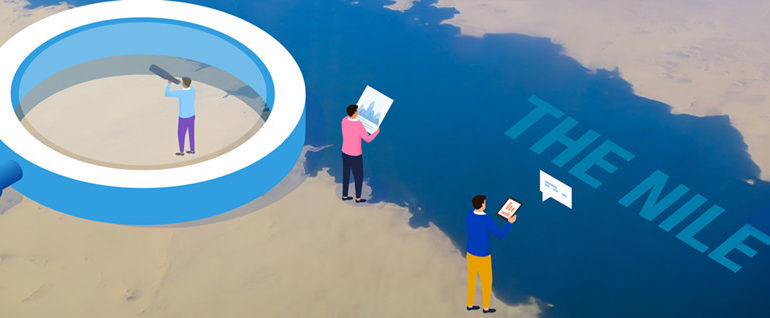The Nile basin, for the first time in its history, is experiencing a change in the status quo of the region. This is largely due to the Grand Ethiopian Renaissance Dam (GERD). The historical hegemonic position of Egypt is no longer secure and the biased and un-just water allocation arrangement in the basin is experiencing an unprecedented backlash. Amidst all of this, the push for an equitable and reasonable use of the Nile waters is also growing. The Nile Basin’s future is now at a crossroad. The time is ripe for change and it would be wise to capitalize on the momentum of the current situation to push for change.
The Nile basin consists of eleven countries: Tanzania, Uganda, Rwanda, Burundi, the Democratic Republic of the Congo, Kenya, Ethiopia, Eritrea, South Sudan, Republic of the Sudan, and Egypt. The basin has lagged so far behind the rest of the world in terms of equitable and reasonable use of the available Nile River capacity. But the silver lining here is that we have the luxury to learn from good practices and pitfalls experienced in other transboundary water basins worldwide. The world is by no means short of wisdom and knowledge on how to manage transboundary waters. Transboundary waters are abundant, with more than 276 shared rivers and lakes across the world, accounting for 80% of the world’s freshwater supply, 50% of the world’s surface and 40% of the entire global population depend on them for basic water needs. The history of transboundary water management goes back Millenia. Back in 2550 B.C the Sumerian states of Lagesh and Umma had an agreement on the shared use of the river Tigris which involved land, tenancy and a crop sharing agreement as part of the water allocation scheme. There is clearly something to learn here; even these ancient people knew water sharing needed to go beyond physical water allocation.
In more recent history, we have examples of good practices from several continents of the world. Starting with Africa, we find the Senegal and Niger river basins present exemplary practices of collaboration. These two basins explicitly consider water as a human right and not as an economic commodity which sets them apart from other basins. The Senegal River basin shared by Senegal, Mali, Mauritania and Guinea, is a world class example of collaboration and mutual use. After a severe war in the Sahel regions in the 1970’s these countries came together to utilize their shared resources. Their basin wide organizations, The Senegal River Basin Development Organization (OMVS) and The Niger Basin Authority (ABN) for the Niger basin, are both organizations with teeth, with the highest authority. The issues of competing use of the water which is apparent in any transboundary basin was also present in the Senegal River Basin. Senegal and Mauritania wanted to use the water for irrigation and hydropower while Mali wanted to capitalize on navigation on the waters. Under normal circumstances if the countries aimed at capitalizing just their national interests it would have been chaos. However, underlining their shared need instead of their differences, these three countries commissioned a joint project, The Manantali Dam in Mali, which serves the navigation needs of Mali as well as the hydropower and irrigation needs of Senegal and Mauritania. This is the fruit of cooperation.
Another exemplary practice can be found in Southern Africa in the Orange Senqu River Basin, shared by Botswana, Namibia, Lesotho and South Africa. This basin can teach us multiple exemplary practices from having an inclusive river basin organization including all riparian countries such as the Orange-Senqu River Commission (ORASECOM) to adopting and abiding by international principles. The famous story of benefit sharing between South Africa and Lesotho is also an inspiring one. In 1986 Lesotho and South Africa agreed that Lesotho would provide water to South Africa while producing hydropower from its dam while South Africa would pay royalties for the water it gets from Lesotho. This trend has led to the building of numerous joint dams in the region. This arrangement has allowed these countries to save water from evaporation loss and increase efficiency of water delivery as Lesotho is a highland country. This is an example of how we can capitalize on the benefits of shared water if we have a regional outlook.
The Yukon River Basin shared by the US and Canada also teaches us the value of incorporating indigenous knowledge and people in transboundary water governance practise. The Yukon River inter-tribal council (YRITWC) is a community of interest with significant authority in the basin. This basin is so far ahead into the future in terms of its practice as it makes the case for a community of interest in the management of transboundary waters, which is the next phase in the evolution of transboundary water management theories.
Another basin to mention as an example of good practices is the Rio Grande River Basin shared by the US and Mexico. The Harmon doctrine, which states that upstream countries have the absolute right to use the waters in their territories regardless of the impact downstream was initiated from this case. But the US did not act on this advice and instead showed interest in catering for the needs of Mexico. This basin is an example of mutual respect, the need for evolving treaties, climate proof agreements and equitable water basin use for the future. The agreement between Mexico and the US also has mechanisms for compensation. In this agreement, the US agreed to pay the full cost of the dam that was built as part of the water management agreement and any costs related to delivery of water from the US to Mexico as compensation for past injustices. In turn Mexico would relinquish past grievances henceforth. In addition, Minute 319 signed in 2012 as a development on the original treaty of 1944 between the US and Mexico caters for impending impacts of climate change, an example of an evolving treaty.
The above cases are specific instances of how transboundary water governance can be done right. However, the UN has also studied various basins across the world and summarized good and bad practices to take note of. Among the lessons: having an inclusive system with all players involved, establishing a river basin organization with serious authority, and accounting for future changes. In the same line of future proofing a basin against upcoming changes in water availability such as climate change and increased water demand, rigid and fixed water allocation treaty or scheme is also not in the best interest of basins. This is the current state of events in the Nile Basin, something that should absolutely change. International experience shows that a flexible water allocation scheme in terms of proportions or shared benefits better serves the purpose.
Other important take-aways are establishing a clear dispute resolution mechanism, avoiding unilateral developments, rather ensuring equitable and reasonable use as well as benefit sharing schemes and joint projects. Developing trust among riparian countries, information sharing, holistic, inclusive and future proof management, are also among these good practices.
This article has shown that the Nile basin has a lot of international and local experiences to draw from which it should definitely take advantage of. We do not have to start from scratch. However, we should note that these lessons are generic. Contextualization of these lessons to the appropriate context of each basin is of paramount importance. Consideration should also be given to the socio economic, historic and political circumstance of the basin in question. This is especially important in the Nile Basin which has a convoluted history going back thousands of years.

Mekdelawit Messay Deribe
Mekdelawit Messay Deribe is a Civil Engineer and an Environmental Scientist working on water science research and Nile related studies. She is an independent researcher and a prospective PhD Candidate at Florida International University and is currently doing research on the reasonable and equitable use of the Nile water. She can be reached at mekdelawitmessay[at]gmail.com.

